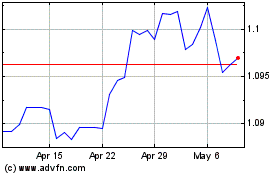Australian Dollar Extends Rally After RBA Raises Economic Growth Forecast
06 November 2018 - 5:58PM
RTTF2
The Australian dollar continued to be higher against its major
counterparts in the European session on Tuesday, after the Reserve
Bank of Australia kept its interest rate on hold and slightly upped
its growth forecast for this year and next.
The board of the Reserve Bank of Australia, governed by Philip
Lowe, voted to maintain the cash rate at 1.50 percent. The interest
rate has been at the current level since August 2016.
"Taking account of the available information, the Board judged
that holding the stance of monetary policy unchanged at this
meeting would be consistent with sustainable growth in the economy
and achieving the inflation target over time," the bank said in a
statement.
The bank raised its forecast for economic growth in 2018 and
2019, which is expected to average around 3.5 percent. Earlier, the
bank expected GDP growth to average 3.25 percent for both this year
and next.
Meanwhile, caution prevailed ahead of key economic and political
events scheduled for the week, which includes the midterm elections
in the U.S., and the Federal Reserve's monetary policy review.
In the US midterm elections, it is expected that the democrats
will regain control of the House while Republicans hold on to a
slender majority in the Senate. Reuters is of the view that global
stocks may rally on hope of more tax cuts if Republicans retain
their House majority.
The currency has been trading in a positive territory against
its major counterparts in the Asian session.
The aussie strengthened to a 4-day high of 0.7240 against the
greenback, from a low of 0.7205 hit at 10:15 pm ET. The aussie is
poised to find resistance around the 0.74 level.
The aussie firmed to 81.97 against the yen, its highest since
October 2. The aussie is seen finding resistance around the 83.00
region.
Data from the Ministry of Internal Affairs and Communications
showed that Japan household spending fell 1.6 percent on year in
September, coming in at 271,273 yen.
That was well shy of expectations for an increase of 1.5 percent
and down sharply from the 2.8 percent gain in August. After falling
to 1.5832 against the euro at 10:15 pm ET, the aussie reversed its
course and touched a 4-day high of 1.5755. On the upside, 1.55 is
possibly seen as the next resistance level for the aussie.
Survey data from IHS Markit showed that Eurozone's private
sector expanded at the weakest pace in over two years in October as
both manufacturing and services recorded slower rates of
growth.
The composite Purchasing Managers' Index, or PMI, fell to 53.1
from September's 54.1. The reading was the lowest since September
2016. The flash reading for the composite PMI was 52.7.
The aussie appreciated to 0.9497 against the loonie, a level not
seen since September 6. Next key resistance for the aussie is
likely seen around the 0.96 area.
The aussie held steady against the kiwi, after having advanced
to a 4-day high of 1.0851 at 11:30 pm ET. The pair was valued at
1.0813 when it closed deals on Monday.
Looking ahead, at 8:30 am ET, Canada building permits for
September will be out.
AUD vs NZD (FX:AUDNZD)
Forex Chart
From Mar 2024 to Apr 2024

AUD vs NZD (FX:AUDNZD)
Forex Chart
From Apr 2023 to Apr 2024
